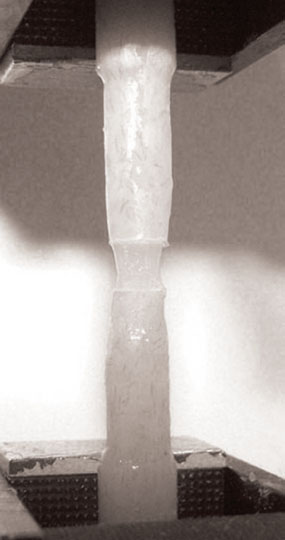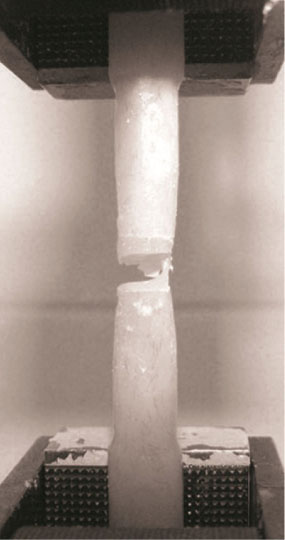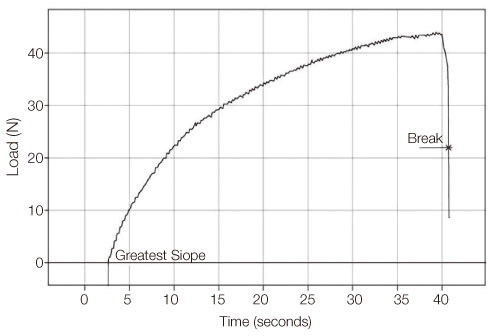J Adv Prosthodont.
2014 Apr;6(2):121-125. 10.4047/jap.2014.6.2.121.
Investigation of bonding properties of denture bases to silicone-based soft denture liner immersed in isobutyl methacrylate and 2-hydroxyethyl methacrylate
- Affiliations
-
- 1Department of Prosthodontics, Faculty of Dentistry, Cumhuriyet University, Sivas, Turkey. drhknkn@hotmail.com
- KMID: 2233340
- DOI: http://doi.org/10.4047/jap.2014.6.2.121
Abstract
- PURPOSE
The purpose of this study was to investigate the bonding properties of denture bases to silicone-based soft denture liners immersed in isobutyl methacrylate (iBMA) and 2-hydroxyethyl methacrylate (HEMA) for various lengths of time.
MATERIALS AND METHODS
Polymethyl methacrylate (PMMA) test specimens were fabricated (75 mm in length, 12 mm in diameter at the thickest section, and 7 mm at the thinnest section) and then randomly assigned to five groups (n=15); untreated (Group 1), resilient liner immersed in iBMA for 1 minute (Group 2), resilient liner immersed in iBMA for 3 minutes (Group 3), resilient liner immersed in HEMA for 1 minute (Group 4), and resilient liner immersed in HEMA for 3 minutes (Group 5). The resilient liner specimens were processed between 2 PMMA blocks. Bonding strength of the liners to PMMA was compared by tensile test with a universal testing machine at a crosshead speed of 5 mm/min. Data were evaluated by 1-way ANOVA and post hoc Tukey-Kramer multiple comparisons tests (alpha=0.05).
RESULTS
The highest mean value of force was observed in Group 3 specimens. The differences between groups were statistically significant (P<.05), except between Group 1 and Group 4 (P=.063).
CONCLUSION
Immersion of silicone-based soft denture liners in iBMA for 3 minutes doubled the tensile bond strength between the silicone soft liner and PMMA denture base materials compared to the control group.
MeSH Terms
Figure
Reference
-
1. McCabe JF, Carrick TE, Kamohara H. Adhesive bond strength and compliance for denture soft lining materials. Biomaterials. 2002; 23:1347–1352.2. Machado AL, Breeding LC, Puckett AD. Effect of microwave disinfection on the hardness and adhesion of two resilient liners. J Prosthet Dent. 2005; 94:183–189.3. León BL, Del Bel Cury AA, Rodrigues Garcia RC. Water sorption, solubility, and tensile bond strength of resilient denture lining materials polymerized by different methods after thermal cycling. J Prosthet Dent. 2005; 93:282–287.4. Usumez A, Inan O, Aykent F. Bond strength of a silicone lining material to alumina-abraded and lased denture resin. J Biomed Mater Res B Appl Biomater. 2004; 71:196–200.5. Botega DM, Sanchez JL, Mesquita MF, Henriques GE, Consani RL. Effects of thermocycling on the tensile bond strength of three permanent soft denture liners. J Prosthodont. 2008; 17:550–554.6. Braden M, Wright PS. Water absorption and water solubility of soft lining materials for acrylic dentures. J Dent Res. 1983; 62:764–768.7. Kulak-Ozkan Y, Sertgoz A, Gedik H. Effect of thermocycling on tensile bond strength of six silicone-based, resilient denture liners. J Prosthet Dent. 2003; 89:303–310.8. Murat H, Taguchi N, Hamada T, McCabe JF. Dynamic viscoelastic properties and the age changes of long-term soft denture liners. Biomaterials. 2000; 21:1421–1427.9. Akin H, Tugut F, Mutaf B, Akin G, Ozdemir AK. Effect of different surface treatments on tensile bond strength of silicone-based soft denture liner. Lasers Med Sci. 2011; 26:783–788.10. Akin H, Tugut F, Mutaf B, Guney U, Ozdemir AK. Effect of sandblasting with different size of aluminum oxide particles on tensile bond strength of resilient liner to denture base. Cumhuriyet Dent J. 2011; 14:5–11.11. Amin WM, Fletcher AM, Ritchie GM. The nature of the interface between polymethyl methacrylate denture base materials and soft lining materials. J Dent. 1981; 9:336–346.12. Bolayır G, Demir H, Doğan A, Boztuğ A, Doğan OM, Soygun K. Effects of different high alkyl methacrylate monomers on tensile bond strength between resilient liner and acrylic resin. Mater Res Innov. 2009; 13:431–435.13. Craig RG, Gibbons P. Properties of resilient denture liners. J Am Dent Assoc. 1961; 63:382–390.14. Jacobsen NL, Mitchell DL, Johnson DL, Holt RA. Lased and sandblasted denture base surface preparations affecting resilient liner bonding. J Prosthet Dent. 1997; 78:153–158.15. Storer R. Resilient denture base materials. Part 1, introduction and laboratory evaluation. Br Dent J. 1962; 113:195–203.16. Tugut F, Akin H, Mutaf B, Akin GE, Ozdemir AK. Strength of the bond between a silicone lining material and denture resin after Er:YAG laser treatments with different pulse durations and levels of energy. Lasers Med Sci. 2012; 27:281–285.17. Mutluay MM, Ruyter IE. Evaluation of bond strength of soft relining materials to denture base polymers. Dent Mater. 2007; 23:1373–1381.18. Johnson JA, Jones DW. The mechanical properties of PMMA and its copolymers with ethyl methacrylate and butyl methacrylate. J Mater Sci. 1994; 29:870–876.19. Hatamleh MM, Maryan CJ, Silikas N, Watts DC. Effect of net fiber reinforcement surface treatment on soft denture liner retention and longevity. J Prosthodont. 2010; 19:258–262.20. Çökeliler D, Erkut S, Zemek J, Biederman H, Mutlu M. Modification of glass fibers to improve reinforcement: a plasma polymerization technique. Dent Mater. 2007; 23:335–342.21. Keyf F, Uzun G, Mutlu M. The effects of HEMA-monomer and air atmosphere treatment of glass fibre on the transverse strength of a provisional fixed partial denture resin. J Oral Rehabil. 2003; 30:1142–1148.22. Doğan OM, Bolayır G, Keskin S, Boztuğ A, Doğan A, Bek B. Effects of some methacrylate monomers used as liquid component on tensile and flexural strengths of poly (methylmethacrylate) denture base resin. Mater Res Innov. 2006; 10:424–427.23. Leles CR, Machado AL, Vergani CE, Giampaolo ET, Pavarina AC. Bonding strength between a hard chairside reline resin and a denture base material as influenced by surface treatment. J Oral Rehabil. 2001; 28:1153–1157.24. Vargün E, Sankira M, Aran B, Sankira ND, Usanmaz A. Synthesis and Characterization of 2-Hydroxyethyl Methacrylate (HEMA) and Methyl Methacrylate (MMA) Copolymer Used as Biomaterial. J Macromol Sci A. 2010; 47:235–240.25. al-Athel MS, Jagger RG. Effect of test method on the bond strength of a silicone resilient denture lining material. J Prosthet Dent. 1996; 76:535–540.26. Aydin AK, Terzioğlu H, Akinay AE, Ulubayram K, Hasirci N. Bond strength and failure analysis of lining materials to denture resin. Dent Mater. 1999; 15:211–218.27. Waters MG, Jagger RG. Mechanical properties of an experimental denture soft lining material. J Dent. 1999; 27:197–202.28. Kutay O. Comparison of tensile and peel bond strengths of resilient liners. J Prosthet Dent. 1994; 71:525–531.
- Full Text Links
- Actions
-
Cited
- CITED
-
- Close
- Share
- Similar articles
-
- A comparison study on shear bond strength of 3D printed resin and conventional heat-cured denture base resin to denture relining materials
- Effect of denture base surface pretreatments on the tensile bond strength between a resilient liner and a processed denture base resin
- the Effects of Mono-Poly on The Soft Denture Liners
- THE STUDY ON THE PHYSICAL PROPERTY OF THE PERMANENT SOFT DENTURE LINERS
- Tensile bond strength of four denture resins to porcelain teeth with different surface treatment






